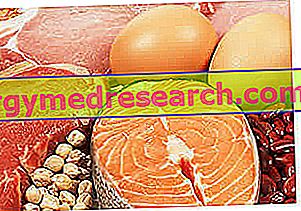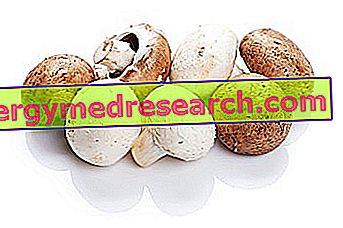For several years now, the use of more protein in diets for weight loss is considered the elite expedient to optimize the results obtained through traditional low-calorie diets. However, as we will see below, if it is true that greater amounts of protein for weight loss can have a positive effect on the reduction of body fat, it is equally true that some parts of the body may be negatively affected by the excess of protein, causing some small (or, in the long term, large) metabolic-functional imbalances.

Protein for weight loss: what are they?
Proteins are energy macronutrients that provide 4kcal / g; these are polymers (complex chains) of amino acids (aa) which, in addition to containing carbon (C), hydrogen (H) and oxygen (O), possess an amino group inclusive of nitrogen (N).
In nature, the protein chains (also known as peptides ) have many biological functions and, as such, are characterized by an extreme structural heterogeneity: primary (or simple), secondary (in α-helix or β-leaflet ), tertiary ("a gomitolo") or quaternaria (several balls "tangled" between them).
Food proteins, taken in large quantities to lose weight at the expense of carbohydrates and lipids, are found in ALL foods; however, food proteins are extremely different from each other, since their amino acid composition varies according to the biological function in the food [organism or primary food source (milk)] in which they are found. The proteins can therefore be classified into simple: protamines, histones, albumins, globulins, glutelins, prolamins, phosphoprotides and scleroprotides, and composites (including hemoglobin, chlorophylls and opsins). This distinction between the various proteins, from a nutritional point of view, leaves the time it finds; what is most interesting in terms of food is in fact what is called biological value (VB). This term of comparison is based on the quantitative estimate and on the relationship between the various amino acid monomers (aa essential and non-essential aa) within the protein; to prove to ALTO VB, this relationship must be similar to that which characterizes the various aa of human proteins or, alternatively, of the egg (for more details, see the article: "Biological Value").
Origin of proteins for weight loss: greater clarity
The VB of proteins taken to lose weight is a parameter that, in reality, should not constitute more than a simple quibble; this statement is justifiable by contextualizing (with objectivity and scientificity) the importance of the VB to the absolute quantity of dietary proteins introduced with the diet. As many readers will already know, this parameter estimates the presence of essential aa, ie those that the human organism is NOT able to synthesize independently; on the other hand, the detail that often escapes the attention of those who prefer proteins to lose weight is that: by increasing the ABSOLUTE peptide percentage, therefore indistinctly between high, medium and low VB peptides, the risk of incurring a deficiency is almost null .
This very common misunderstanding is generated (and fomented) by misinformation in the chemical-food sector; that is, the idea that many have on the subject means a medium or low VB protein as a "poor or non-aa essential" polymer, but it is not! Mostly, these amino acid chains differ from the human ones due to the "percentage" (and not absolute!) Lack of one or more essential aa that, fortunately, are normally present in proteins contained in other foods. The lack of essential aa can only occur in a MONO thematic and / or quantitatively insufficient diet.
To conclude the ample premise, it is advisable to dispel another urban legend (which echoes energetically in body-building gyms), that is that proteins for weight loss and those to build muscle tissue must be derived from foods of animal origin since the plant structural polymers are NOT digestible by humans; it is a wrong concept because it is incomplete and misleading. What must be taken into account instead is that vegetable proteins are often accompanied (if they belong to raw vegetables) to considerable amounts of dietary fiber; this fibrous component, NOT digestible for humans, constrains certain structural peptides of the food and can limit both digestion and absorption. However, in a balanced diet (which includes about 30g / day of dietary fiber), the risk of malabsorption is almost non-existent, except for pre-existing pathological conditions (hypochloridria, pancreatic enzyme deficiency, intestinal enzyme deficiency, etc.). Moreover, I remember how the term "vegetable proteins" is qualunquistic or approximate, since the proteins of legumes, cereals and potatoes, in addition to boasting a VB greater than those of vegetables, may possibly enjoy a lower amount of fiber in the food and greater digestibility. Last but not least, cooking; consuming a raw vegetable (which certainly uses more quantities of thermolabile vitamins and otherwise degraded or dispersed mineral salts with thermal or physical treatment) limits its digestibility, as well as cooking and some manipulations (peeling, cutting, minced, whipping), pesto etc.) are able to promote it.
Having finally enlightened readers on the fact that protein for weight loss (if taken in excess) can also come from plant sources and not just animals, let's try to understand WHY it should be necessary to choose a similar strategy at the expense of nutritional balance.
Protein for weight loss: satiety
A diet characterized by a quantity of proteins that is quantitatively or higher than the norm is called hyperproteic or (imprecisely) protein (read the articles: "Protein diet to lose weight" - "Example of a protein diet to lose weight" - "Example of a high-protein diet").
The first reason that drives a pseudo-professional or a user to undertake a protein-based strategy for weight loss refers to the greater satiety they confer compared to carbohydrates and lipids. Leaving aside the physiology of hormonal and nervous feed-backs that regulate the mechanism of satiety (really numerous and complex, which would deserve not only an article, but an entire treatise), some studies conducted at the University of Washington have examined a considerable satiating potential of the proteins in comparison to that produced by sugars and lipids; it seems that assuming the same energy (kcal / 100g of product) from foods with a high protein content compared to other predominantly lipid or glycidic ones, the perception of satiety comes more easily and more quickly; in addition, a distinction should also be made between the various proteins. A very recent study has revealed an exceptional predisposition of fish proteins to lose weight; it seems that, on the rat, these demonstrate a high capacity to stimulate the secretion of the gastrointestinal mediators responsible for satiety, namely the cholecystokinin (CCK) and the glucagon peptide-1 (GPL-1). The result would therefore consist of a physiological improvement of body weight regulation thanks to greater satiety and lower food intake.
Finally, to complete the picture, let us remember that the use of greater quantities of protein for weight loss relies on a further metabolic mechanism, namely the specific dynamic action of foods (ADS); this parameter, which can be decomposed into a specific dynamic action of NUTRIENTS, measures the metabolic cost necessary to digest and metabolize energy molecules. Well, by virtue of the digestive commitment (above all gastric), of the operations of transamination, deamination and urea cycle, the proteins (or better, the amino acids that compose them) constitute the most "demanding" molecules to manage, which is why, by themselves, contribute to increasing the body's energy consumption by promoting weight loss.
Protein for weight loss: usefulness in the diet of the average Italian
All these aspects obviously play an essential role in controlling the low-calorie-slimming diet ... especially in Italy; this clarification, which to a first analysis would not find any plausible explanation, is motivated by the high frequency and by the large portions of consumption referred to foods with greater load and glycemic index (and relative energy density) considered "typical national". The average Italian, in fact, drags behind various eating habits that, if they wore a brush half a century ago, today must cope with a caloric expenditure equal to 50% of that of the period in question, inevitably causing a weight increase in the general population . Pasta, bread and olive oil which, if used correctly could be the key to a healthy and balanced diet, currently, in statistics, figure as the object of food abuse par excellence, transforming the true Mediterranean diet ( as a panacea of metabolic pathologies and "holy grail" of the longest-lived populations in the world) in a diet distorted and potentially harmful. Let it be clear, even temporarily eliminating them from the diet and promoting the consumption of a greater quantity of protein to lose weight, sooner or later, the user will again have to come to terms with these products, which is why the "fashionable" hyper-protein dietary patterns offer results that - although very good in the immediate term - are mainly characterized by the yo-yo effect, due to the lack of nutrition education in the therapy itself (which, if well done, leads the subject to a greater awareness of their nutritional needs ).
Excess protein for weight loss: too much!
In a balanced diet, proteins should constitute a percentage of 12-13% of calories for a sedentary person, and in any case never exceed 20% of the total energy for any subject, even if an athlete or sportsman; this last value, which would make your hair straighten at any dietetic and nutrition academy, is obviously to be considered as a maximum tolerance limit, and NOT as a real BALANCE parameter; on the other hand, we recall that in the disciplines of strength, in which a conspicuous increase in muscle mass is involved, it is quite common to use estimates of calculation of the peptide requirement which involve the use of protein coefficients per kilogram of body weight (physiological or real) equal to 1.5-1.7g / kg.
With regards to slimming diets, currently we are witnessing a real invasion of "disposable" diets, or strategies mainly focused on the profit of the inventor but not very respectful of the scientific canons underlying a correct nutritional distribution; these modalities of accelerated weight loss are based on the increase of proteins in order to lose weight more quickly and, according to the authors, losing less muscle mass as possible.
Starting from the assumption that by increasing the proteins in the diet to lose weight, in order to respect the concept of hypocaloricity, it is necessary to reduce the proportion of fats and, alas, even that of carbohydrates, the new "dietary patterns" do not become ductile to sports nutrition, of the infant, of the pregnant, of the nurse of the elderly, of the nephropathic, of the hepatopathic etc. By subtracting carbohydrates and lipids from the diet, increasing the proteins, the risk of:
- Accumulation of ketone bodies
- Dehydration
- Overloading of the liver and kidneys due to continuous deamination, transaminations, urea cycles and disposal of nitrogen groups
- Worsening of the PRAL
- Alteration of the ratio of saturated and unsaturated fatty acids
- Excess of dietary cholesterol
- Glucose deficiency for the nervous system
- Excessive gastric engagement
- Alteration of intestinal bacterial flora
- Constipation.
Obviously, the most serious consequences are the asymptomatic ones, namely liver and kidney overload. These consequences, which rarely begin because of excess proteins to lose weight (except in mild acute cases) but are inexorably fed, should lead the reader to appropriate reflection. In my opinion, the suffering of the organs responsible for digestion and waste disposal can be seriously compromised only through the sum of several risk factors, such as: drugs, doping, alcoholism, drug addiction, diet, etc. This does not mean that excess protein is one of the potential risk factors involved; so ... why risk it?
A correct and balanced diet, even if self-managed, is always the desirable solution in order to reduce overweight as a compromising element of lifestyle and good general health.



